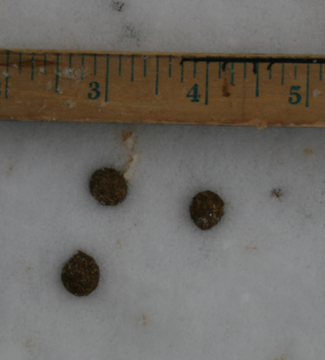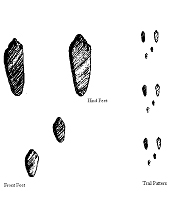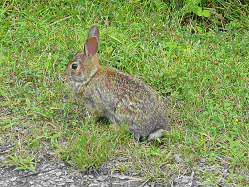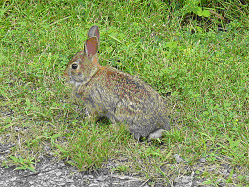Rabbits and Hares
Organizations:
I have not heard of one yet that pertains to both Rabbits and Hares. There are various clubs that focus on one over the other. Please email me with any links and we will post here – contact TC
Rabbits and Hares Descriptions
– Rabbits are defined as medium-sized grazing mammals with long ears, long hind legs and bulging eyes on the sides of their heads. There are 18 different species living in the U.S. and Canada.
The male, is called a buck The female, called a doe, is larger than the buck.
Rabbits are primarily nocturnal animals. They can detect enemies by scent. They are extremely able runners and can switch direction in an instant, making them an extremely tough game animal to hunt.
Hares are generally larger than rabbits and, except for the snowshoe hare, are found in more open territory. Their young are generally born more fully developed.
Below are general descriptions of three of the more common species found in North America:
Eastern Cottontail – Very common in its range of the eastern US. Coloration is grayish brown above, grizzled with black. There usually is a white spot on the forehead. Tail is cottony white and the feet are white above. The cottontail has long ears. The cottontail is approximately 14 ¾” – 18 ¼” long and weighs between 2 – 4 lbs. The hind foot is usually between 3 3/8″ – 4 1/8″ long. Habitat – Brushy areas, old fields, woods and farms.
New England Cottontail – Coloration is brownish sprinkled liberally with black. As opposed to the Eastern Cottontail, which has a white spot on its forehead, the New England Cottontail has a black patch on its forehead. Its ears also are outlined by a black stripe. Tail is cottony white below and the feet are white above. This cottontail is approximately 14 ¼” – 19″ long and weighs between 1 ½ – 3 lbs. The hind foot is usually between 3 ¼” – 4″ long. Habitat – Brushy areas, old fields, woods and farms.

Snowshoe Hare – In summer color this hare is dark brown with a small tail dark above and dusky to white below. In the winter, mottled white with brown to white, with black-tipped long ears. This animal has large hind legs that are well furred, hence the name. In certain parts of the country they may not change color. In the Adirondack Mountains, black individuals have been observed. This hare is approximately 15 – 20″ long and weighs between 2 – 3 lbs. The hind foot is usually between 3 7/8″ – 5 7/8″ long. Habitat – Northern forests.
Rabbits and Hares Food
– As stated previously, rabbits and hares are grazing animals. Greens, berries and in the winter woody material (such as my blueberry bushes) are eaten. You can tell a bush eaten by a rabbit, it usually looks as a clean cut at an angle (as opposed to deer that usually leave a ragged appearance). Bark of trees may be stripped 3-4″ from the ground. Breeding – Rabbits have the ability to breed several times per year. Their litters can average from 1 -6 (snowshoe); 1-9 (Eastern Cottontail); 3-8 (New England Cottontail) young. Gestation period is roughly 28 days but does vary by species. The Eastern Cottontail has the ability to have 4 litters each year – that is a possible total of 36 rabbits each breeding season. This is nature’s way of providing survival potential since almost all predators prey on them.

Scat – Small pea sized and rounded. Usually in piles. This is one of the sure signs rabbits are around. They are like their domestic cousins, they eat and poop continually.
For jackrabbits, which are not only bigger but also tougher than other hares and rabbits, many hunters use hollow-points, some use 22 Magnums, and some even use .22 centerfire cartridges associated with long-range chuck shooting. When I lived out west, I would shoot jackrabbits with my 22-250. For those that want to attempt target practice with hunting, try this.
When rabbit hunting with a shotgun, missing is often caused by swinging ahead of the target and overshooting as the bouncing “bunny” abruptly switches course and vanishes. A smooth swing and good understanding of your guns performance are of little avail in this situation, so a majority of experienced rabbit gunners, whether they realize it or not are snap-shooters. They knock over rabbits the way many of us knock down grouse or woodcock, by getting on target fast and snapping off a shot the instant the muzzle passes the rabbit.
If you want to be prepared for opening season and make quick clean kills, get practice at a local range. Many clubs offer “running clays” that simulate rabbits. Take the time, spend the money and practice. It will not only make you a better shot, but will bring you in touch with others that share you passions.
Hunting rabbits can bring you through all types of country, everything from slash piles, greenbrier tangles, brush, shrubs, and high weeds of typical cottontail country to open fields where I sometimes walk up on other upland game.
Hunting Strategies:
Hunting alone – When hunting alone for rabbits, as for most small game, it pays to pause now and then and switch directions slightly. This can unnerve and flush a rabbit from hiding just as it can flush a grouse or other game animal. Tracking rabbits on snow is often productive, even snowshoe hares that have turned winter white may be spotted by their dark eyes and ear tips, though their body may be almost winter white and sitting in screening cover. Having spotted a snowshoe hare, or any hare or rabbit, it’s often possible to stalk within gunning distance.
Hunting with partners – When hunting cottontails with friends, you can stage a rabbit drive. This doesn’t require standers to Intercept the game, because a rabbit’s first defense is to freeze at the approach of danger, hoping to escape detection. It moves when it senses that the hope is gone, and by then, you’ll, generally be quite close. Just form a line, spacing the hunters at wide intervals, and walk through fields, brushy meadows, and other promising patches of low cover. While jumping rabbits this way, you may also walk up on other upland game.
Hunting with dogs – When hunting with beagles (or other dogs – I used to have a Springer Spaniel that was an excellent rabbit dog), there’s a strong temptation to follow the dogs every time they start to chase a rabbit. This is precisely the wrong tactic unless your dogs are too pushy-in which case the rabbit will dive for a hole and whatever you do probably won’t matter. If your dogs press along with no terrifying rush, a rabbit will most often move in a rough circle of no more than a few hundred yards. It is traveling through its home grounds, confident that it can elude its present pursuers just as it has eluded predators. You won’t keep up with the dogs or the rabbit anyhow, so just wait in a fairly open spot or on the nearest little rise, preferably close to where the hounds first got hot. The rabbit will probably come bounding back, presenting a shot.
A young snowshoe hare will often behave like a cottontail when pursued by dogs. An older, more experienced one will often move over a much greater radius. Its first circle may cover a mile and never bring the game within your view. Find a fair vantage point commanding possible crossings. Try to stand where you’ll be inconspicuous, if not hidden, and be patient. Subsequent circles will shrink. The chase may be quick or it may last for hours. An exception to the rule occurs if the hounds soon move out of your hearing and seem to have taken a fairly straight course. Sometimes an old, experienced snowshoe hare runs straight out for quite a distance before circling. If this seems to be the case, you’ll be well advised to follow for a while and then take a stand where the hound music again grows loud.
A warming trend after a cold spell makes for good hunting, regardless of which kind of rabbit you’re after and good places to look then are grassy, weedy, or brushy stretches along creeks and ditches. When cottontails are the game, be sure to check any strips of sumac,particularly if the strips have heavy ground cover. Sumac bark has a high fat content and cottontails love it as a winter food.
In very cold weather below about 12° cottontails hole up in burrows, dens, and the like. I generally hole up too, in that kind of weather, but snowshoe hares don’t. If you can take the cold, try combing the dense conifer swamps for snowshoes in midwinter. Jacks, too, usually stay out in cold weather. They may be warming themselves in brushy depressions, moving about searching for food, or sunning themselves on the warmer sides of hills.
Try not to dress a rabbit in the field, much less reward a dog with a bite of raw meat. There’s a hazard to dogs in this practice. Watery cysts called “bladder worms” are sometimes found in a rabbit’s body cavity. They’re larval tapeworms of a kind that can’t mature in a rabbit and are harmless to man, but are very dangerous to dogs.
Another rabbit parasite-fortunately, one that is no longer common is the Bacterium tularence, the producer of tularemia, or “rabbit fever”. It’s carried from rabbit to rabbit by ticks, fleas, and other biting insects. The meat of an infected rabbit is perfectly safe; to eat if thoroughly cooked, but it is possible for a human to contract this disease through a cut or abrasion. Check with your state game department if you have concerns or questions regarding if any diseased rabbits have been discovered and how best to handle raw meat. To find information about your local state agency check out our state agency page.
If you want to practice shooting – download the rabbit target.



